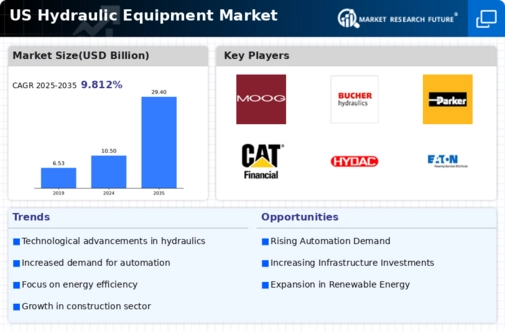Rising Demand in Construction Sector
The construction sector in the US is experiencing a notable resurgence, which appears to be a primary driver for the hydraulic equipment market. As infrastructure projects gain momentum, the need for hydraulic machinery, such as excavators and loaders, is likely to increase. According to recent data, the construction industry is projected to grow at a CAGR of approximately 5% over the next five years. This growth is expected to stimulate demand for hydraulic equipment, as these machines are essential for various construction tasks. Furthermore, the trend towards urbanization and the development of smart cities may further bolster the hydraulic equipment market, as advanced machinery is required to meet the demands of modern construction practices.
Government Infrastructure Investments
Government investments in infrastructure are a significant driver for the hydraulic equipment market. The US government has announced various initiatives aimed at upgrading and expanding infrastructure, which is likely to create substantial demand for hydraulic machinery. These investments are expected to focus on transportation, utilities, and public facilities, all of which require hydraulic equipment for construction and maintenance. Recent reports indicate that federal infrastructure spending could reach $1 trillion over the next decade, suggesting a robust market opportunity for hydraulic equipment manufacturers. This influx of funding may stimulate growth in the hydraulic equipment market as companies respond to the increased demand for reliable and efficient machinery.
Increased Automation in Manufacturing
The manufacturing sector in the US is increasingly adopting automation technologies, which could significantly impact the hydraulic equipment market. Hydraulic systems are integral to automated machinery, providing the necessary power and precision for various manufacturing processes. As industries strive for efficiency and productivity, the demand for hydraulic equipment is likely to rise. Reports indicate that the automation market is expected to grow by over 10% annually, suggesting a corresponding increase in the need for hydraulic solutions. This trend indicates that manufacturers are investing in advanced hydraulic systems to enhance operational efficiency, thereby driving growth in the hydraulic equipment market.
Expansion of Renewable Energy Projects
The shift towards renewable energy sources in the US is emerging as a crucial driver for the hydraulic equipment market. As the country invests in wind, solar, and hydroelectric projects, the demand for hydraulic equipment is expected to increase. Hydraulic systems are essential in the construction and maintenance of renewable energy facilities, such as wind turbines and solar farms. The renewable energy sector is projected to grow at a CAGR of around 8% in the coming years, which may lead to a heightened demand for hydraulic machinery. This trend suggests that the hydraulic equipment market could benefit significantly from the ongoing transition to sustainable energy solutions.
Technological Innovations in Hydraulic Systems
Technological innovations are playing a pivotal role in shaping the hydraulic equipment market. Advancements in hydraulic technology, such as the development of more efficient pumps and valves, are likely to enhance the performance and reliability of hydraulic systems. These innovations may lead to reduced energy consumption and improved operational efficiency, making hydraulic equipment more appealing to various industries. The market for hydraulic components is expected to witness a growth rate of approximately 6% annually, driven by these technological advancements. As industries seek to optimize their operations, the demand for cutting-edge hydraulic solutions is anticipated to rise, further propelling the hydraulic equipment market.























Leave a Comment